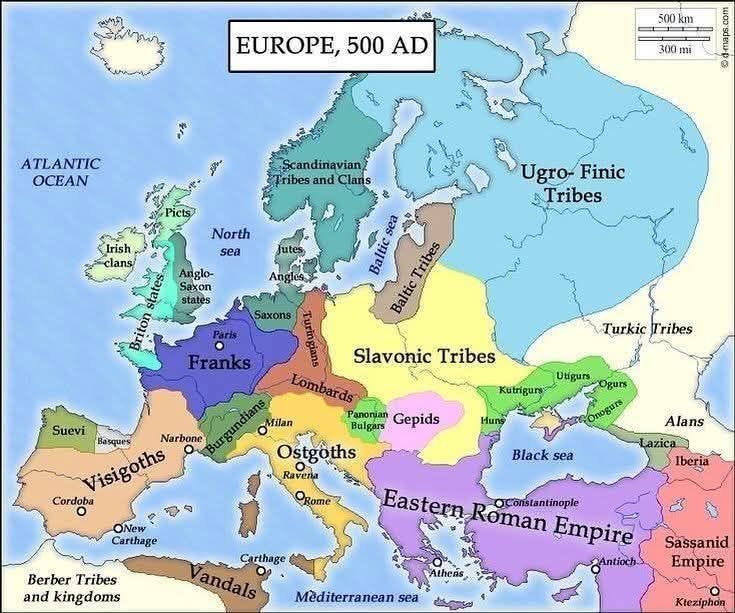TWIL #25 - From Maps in Motion to Flying Snakes
This Week I Learned - Insights, observations, and the stuff that made me go “Whoa!”
Every Sunday, I share a few of my learnings, reflections, and curiosities from the week. Things I stumbled upon, things I questioned, things that made me look twice. It’s not about being right or complete… it’s about noticing, wondering, and learning out loud.
Thanks for reading. I hope it sparks something for you too.
Europe, 500 AD — A map of Europe in motion
This week I came across this map. And I was immediately fascinated and triggered by it…. for me an invitation to follow the history of all these names on the map.
Hold this map like a time machine. The Western Roman Empire is dead. Borders are smoke. Whole peoples are on the move. Some to build kingdoms, some to vanish, all to shape the map you know today.
Follow these tribes from origin, to 500 AD, to where they ended up. This is the hidden life of Europe’s names and nations.
Visigoths — From nomads to Iberian kings
Origin: A branch of the Gothic people from Scandinavia who migrated south through what is now Poland and Ukraine.
500 AD: Ruling most of Iberia (modern Spain and Portugal) and part of Southern Gaul. After sacking Rome in 410 AD, they carved out a stable kingdom with Toledo as their capital.
Now: The Visigothic kingdom fell to the Moors in 711, but their legal codes, noble lineages and early Christian traditions laid the groundwork for the Spanish Reconquista. Gothic churches and place names still whisper their presence.
Vandals — Pirates of the empire
Origin: An East Germanic tribe from the Oder and Vistula rivers in modern Poland.
500 AD: Having crossed the Rhine, ravaged Gaul and Spain, they leapt to North Africa and seized Carthage in 439. They built a pirate kingdom and sacked Rome itself in 455 by sea.
Now: Crushed by the Byzantines in 534. They left few direct descendants, but their name survives in the word vandalism — born from the destruction they caused. Ruins near Tunis and coastal forts still hold their ghost.
Franks — The roots of France
Origin: A confederation of Germanic tribes along the lower Rhine and Meuse rivers.
500 AD: Led by Clovis I, they conquered Roman Gaul and laid the foundation for the Merovingian dynasty, a bridge from Rome to medieval Europe.
Now: The name France is the land of the Franks. They gave rise to the Carolingian Empire under Charlemagne and shaped the French language by blending Latin and Frankish dialects.
Burgundians — Barbarians turned vintners
Origin: A Germanic people who likely came from Bornholm (Burgundarholm) in the Baltic Sea.
500 AD: Settled in the Rhône valley, covering what is now eastern France and western Switzerland. They forged a powerful kingdom after helping topple the Western Roman Empire.
Now: Overrun by the Franks, but the name stuck. Burgundy became a medieval powerhouse famed for wine, knights and intrigue. A legacy you can still taste in a glass of Pinot Noir.
Turkic tribes — The riders who became empires
Origin: Central Asian steppe nomads such as the Kutrigurs, Utigurs and Bulgars, all part of the vast Turkic family roaming from Mongolia to the Black Sea.
500 AD: Migrating westward across the steppe, pressing on the borders of the Eastern Roman Empire and other tribes.
Now: Some Turkic bands became the Bulgars, founders of Bulgaria. Others merged into the Seljuk Turks — conquerors of Anatolia — and the Ottomans, who ended the Eastern Roman Empire and transformed Constantinople into Istanbul.
Angles, Saxons and Jutes — The making of England
Origin: Coastal tribes from today’s Denmark, Schleswig-Holstein and northern Germany.
500 AD: Still clinging to the North Sea’s edge but hungry for new land. By mid-century they were crossing into Roman Britain, pushing native Britons west into Wales and Cornwall.
Now: These tribes fused into the Anglo-Saxons. Angle-land became England. Their dialects grew into Old English: the root of the language you are reading now.
Slavic Tribes — Seeds of slavia
Origin: Indigenous clans from the forest-steppe of Eastern Europe, around the Pripet Marshes and the Dnieper River basin.
500 AD: Scattered clusters with no single kingdom — just loose communities moving south, west and east.
Now: They blossomed into the Poles, Czechs, Slovaks, Russians, Serbs, Croats, Slovenes and many more. The Slavic family today covers nearly half of Europe’s landmass.
Ostrogoths and Lombards — Italy’s Germanic kings
Origin (Ostrogoths): Eastern branch of the Gothic people, cousins to the Visigoths, who migrated from the Black Sea region.
500 AD: Ruling Italy under Theodoric the Great, a short-lived but brilliant revival of Roman administration under Gothic rule.
Now: Byzantium reconquered Italy in the 6th century, but the Lombards, another Germanic people from the Elbe region, swept in soon after. They founded the Kingdom of Lombardy — Northern Italy still bears their name.
Gepids — The Forgotten Rivals
Origin: Another Gothic offshoot from the Baltic region.
500 AD: Holding the Carpathian Basin, today’s Hungary, Romania and Serbia, after defeating the Huns alongside other tribes.
Now: Destroyed by the Lombards and Avars by the late 500s. They vanished as a distinct people, but archaeologists in Romania and Hungary still find rich burial sites and treasures. An invisible kingdom under your feet.
A map of footprints
This map shows no fixed borders… only footprints. Tribes cross rivers. Empires fall. Names vanish or reappear in our passports, street signs and languages. The Angles’ farms, the Burgundians’ wine, the Turks’ empires, the Vandals’ raids. All ripples you can still see if you know where to look.
Next time you sip wine in Burgundy, walk Istanbul’s walls, speak English or puzzle over an old ruin, you are standing on the trails they left behind.
Which ghost shall I chase next? The Picts in Scotland? The Suevi in Portugal? The Alans scattered from Gaul to Georgia? Just say the word. And I will dig up their lost story.
Nature loves to fool you
What is this? What do you see?
No, it’s not a snake.
Look again… it’s the wingtips of an Atlas moth, Attacus atlas, one of the largest moths on Earth. When it lands, the tips of its wings curl and pattern themselves like a coiled snake’s head, complete with false scales and a staring eye.
It’s a simple jungle trick: pretend to be something dangerous when you’re soft and harmless. Birds think twice. Predators hesitate. Meanwhile, the Atlas moth drifts on, silent and huge. A living kite with no mouth, born only to mate, lay eggs, and vanish.
Nature loves to lie beautifully. The Atlas moth is proof.









